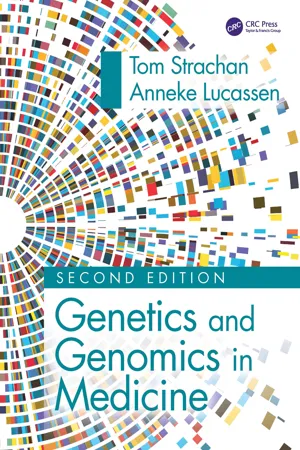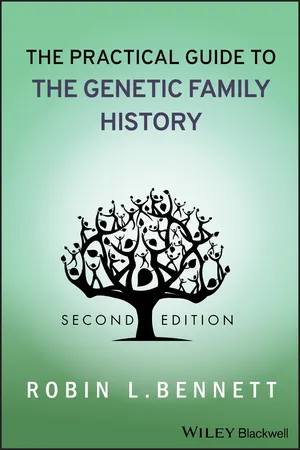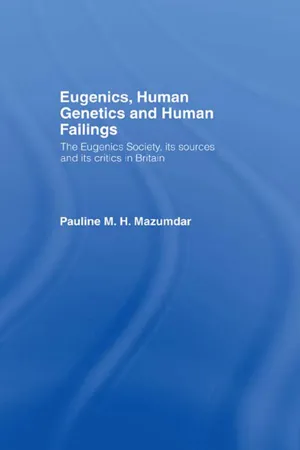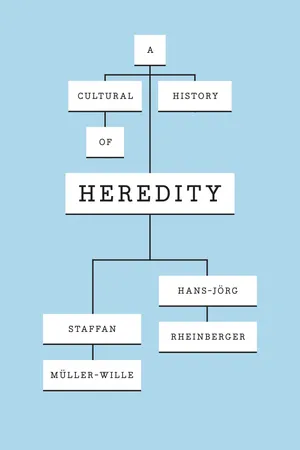Biological Sciences
Pedigree Analysis
Pedigree analysis is a method used to study the inheritance of traits within a family over multiple generations. It involves constructing a family tree to track the occurrence of specific traits and to determine the patterns of inheritance, such as autosomal dominant, autosomal recessive, X-linked, or mitochondrial. This analysis is valuable for understanding genetic diseases and hereditary traits in humans and other organisms.
Written by Perlego with AI-assistance
4 Key excerpts on "Pedigree Analysis"
- eBook - ePub
- Tom Strachan, Anneke Lucassen(Authors)
- 2022(Publication Date)
- CRC Press(Publisher)
McKusick (2007) under Further Reading for further details.GeneCards® (http://www.genecards.org ). A gene-centered database, this contains a large amount of automatically generated entries, mostly relating to specific human genes. It provides substantial biological information about each gene.Investigating family history of disease and recording pedigrees
The extent to which a human disorder has a genetic basis can often be established by taking a family history. Medical records may be available to health service professionals for some family members; details of deceased family members and others who may be difficult to contact may be obtained by consulting more accessible family members.A pedigree is a graphical representation of a family tree that uses the standard symbols depicted in Figure 5.1 . Generations are often labeled with Roman numerals that increase from top to bottom of the page (toward the youngest generation). Individuals within each generation are given Arabic numerals that increase from left to right. An extended family covering many generations may be described as a kindred. A family member through whom the family is first ascertained (brought to the attention of health care professionals) is known as the proband (also called propositus—feminine proposita) and may be marked with an arrow.Pedigree symbols.Figure5.1The term sib (sibling) is used to indicate a brother or sister, and a series of brothers and sisters is known as a sibship. According to the number of steps in the pedigree that links two family members, they may be classified relatives of the first degree (parent and child; sibs); second degree (grandparent and grandchild; uncle/aunt and nephew/niece; half-sibs); third degree (first cousins), and so on. Couples who have one or more recent ancestors in common are said to be consanguineous - Robin L. Bennett(Author)
- 2011(Publication Date)
- Wiley-Blackwell(Publisher)
In genetics, as in all scientific pursuits, the construction and interpretation of a pedigree can be influenced by the political and social beliefs of all-too-human geneticists. Those beliefs may be so ingrained that we mistake them for biological laws. It is, I suspect, beyond our ability to know which of our personal biases we are disguising as scientific truths. The whisper and hints of our biases may be heard only by future generations.The use of pedigrees in clinical medicine has been evidenced for more than a century (Resta, 1993). Even with the advent of molecular and genomic medicine, pedigrees are not a tool of the past but remain an art of the future. The ability to data mine pedigrees in an electronic medical record may be of clinical utility in patient care and may also advance the understanding of disease mechanisms, particularly for common disease.We should proceed with caution as campaigns such as the U.S. Surgeon General’s Family Health Portrait initiative are advocated. The seemingly benign study of pedigree icons as an exercise in understanding human variation and disease can become a potential vehicle for the labeling of normality and abnormality and of distinguishing desirable from undesirable traits (Bennett, 2000). A similar program was instigated in the United States in the early 1920s by the Eugenic Record’s Office (www.eugenicsarchive.org ). Individuals were encouraged to use a standard pedigree format for collecting family history information (Figure 10.1 ). Scientific data were collected for conditions such as “meane, wanderlust, criminal activity, musical ability, and chorea” and given scientific status. By collecting this information, it was expected that persons would be able to make “fit marriages.” The eugenics movement was born. What began with good intentions, at its hey day resulted in mass sterilization programs of those determined to be unfit and the ethnic cleansing horrors of Nazi Germany. Today, crimes against humanity continue under the guise of ethnic cleansing; we must continually monitor that our scientific truths are implemented with ethical clarity.10.7 REFERENCESBennett RL. (2000). Pedigree parables. Clin Genet- eBook - ePub
Eugenics, Human Genetics and Human Failings
The Eugenics Society, its sources and its critics in Britain
- Pauline Mazumdar(Author)
- 2005(Publication Date)
- Routledge(Publisher)
1 They could demonstrate that something was clearly hereditary without implying that it was either a Mendelian unit-character or part of the quantitative spectrum of blended inheritance in the biometric style. Conversely they could be used to demonstrate both of these theories, and even the influence of environment on an inherited constitution. Quite often there was no analysis of the pedigree in terms of any theory of transmission at all: it was the simple fact that like produced like that interested the eugenists. In the period from 1900 to 1930, the period when the Eugenics Society dominated the field, the methodology of human genetics in Britain was in practice the uncommitted pedigree study. In the United States too, the collection of pedigrees was the main method of study. American eugenists standardised and refined the symbolism used, and the British group adopted their conventions. But to the Americans, the pedigree implied a Mendelian interpretation of heredity. Its usefulness lay not only in the straightforward claim that it showed something to be inherited, but also in its ability to distinguish at a glance the dominant and recessive modes of transmission. Skipping a generation at once suggested, or even proved, that a condition was inherited as a Mendelian recessive.German eugenists too began work at the turn of the century with a methodology based on the collection of pedigrees. Many years before either the Americans or the British, the German eugenists began to develop the mathematical models of Mendelism that were to supersede scientifically the simple ad oculos demonstrations of the English literature. But though the pedigree had come to the end of its reign in Germany as a scientific tool, it gained a new significance as the official proof of Aryan descent under the race laws of the Nazi racial state.It is now often said that Mendelism and biometry represented two distinct and incompatible ways of explaining inheritance and evolution and that they were practised in two different camps by different groups of people who saw themselves as enemies. W.B. Provine has suggested that these camps were kept apart by the personal enmity of their leaders, Karl Pearson of the biometricians and William Bateson of the Mendelians.2 - eBook - ePub
- Staffan Müller-Wille, Hans-Jörg Rheinberger(Authors)
- 2012(Publication Date)
- University of Chicago Press(Publisher)
71The debate between biometricians and Mendelians shows that the discourse of heredity was not consolidated only by the application of statistical methods. The analysis of concrete genealogical relationships between ancestors and descendants—in short, the analysis of kinship—was equally important. Dramatic developments in the analysis of kinship occurred during the nineteenth century, although these developments have not received the same attention from historians of biology as the concurrent developments in statistics. Below, we want to identify some of the decisive conceptual steps that were taken in the analysis of kinship and that proved to be relevant to the history of the concept of heredity.72One important step on the way to thinking in terms of heredity was a major extension of the concept of generation that had already begun to take hold toward the end of the eighteenth century. As we have seen in chapter 2 , “generation” had traditionally been used as a synonym of “procreation,” the momentous act of creating a new being. This is also true for the metaphorical meaning that the term had taken on in the context of genealogy and chronology. Historical epochs and degrees of kinship were often defined by the number of successive procreative acts in lines of linear descent, thus defining dynasties, for example. But around 1800, as Ohad Parnes has pointed out, a new concept of generation began to assert itself not only in the life sciences but in the social and cultural sciences as well. Generations were now understood as collectives, encompassing humans or other organisms that were born at roughly the same time. “New was the assumption,” Parnes emphasizes, “that generations are identifiable units within society, and that the members of generations share significantly more than merely the simultaneity of existence.” Most notably, succeeding generations were identified as the carriers of sovereignty in political theories such as those put forward by Thomas Jefferson, who even likened generations and the relationships between them to those of “distinct nation[s].”73
Index pages curate the most relevant extracts from our library of academic textbooks. They’ve been created using an in-house natural language model (NLM), each adding context and meaning to key research topics.
Explore more topic indexes
Explore more topic indexes
1 of 6
Explore more topic indexes
1 of 4



